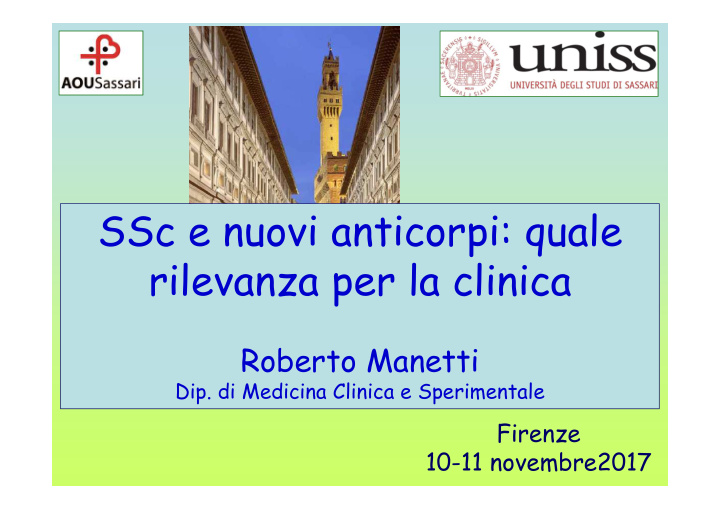



SSc e nuovi anticorpi: quale rilevanza per la clinica Roberto Manetti Dip. di Medicina Clinica e Sperimentale Firenze 10-11 novembre2017
Systemic sclerosis is an idiopathic chronic autoimmune disease characterized by microvascular abnormalities, cutaneous and visceral fibrosis all accompanied by immune abnormalities
> Raynaud’s phenomenon > Involvement of: - Skin - Gastrointestinal tract - Kidney - Cardiovascular system - Lung SSc patients are classified as: - diffuse cutaneous SSc - limited cutaneous SSc - sine cutaneous disease
- Is SSc the correct diagnosis? - Is there a greater risk for involvement of certain organs? - Can the disease course and the vital prognosis be predicted?
2013 ACR/EULAR Criteria for the classification of Systemic Sclerosis
2013 ACR/EULAR Criteria for the classification of Systemic Sclerosis
Autoantibodies are seen at first diagnosis: - in more than 95% of SSc patients - have been associated with distinct disease subtypes - have been associated with differences in disease severity ( including extent of skin involvement, internal organ manifestations and prognosis )
Indirect immunofluorescence technique using HEp-2 continues to be the preferred screening immunoassay to detect most clinically relevant autoantibodies in SSc.
A negative IIF test does not necessarily exclude the presence of a wide spectrum of autoantibodies including: Ku Jo-1 SS-A/Ro60 Ro52 SS-B/La RNA polymerases PM/Scl In case of high clinical suspicion of SSc and a negative IIF test, the identification of autoantibodies should include other specific and sensitive assays
Many of the autoantibodies in SSc target nuclear antigens (ANA was reported to range 85% and 99%)
NUCLEAR FLUORESCENCE “SPECKLED”
“NUCLEOLAR” FLUORESCENCE
“CENTROMERIC” FLUORESCENCE
AutoAbs profile of 528 unselected Australian sera
Anti-centromere antibodies (CENP) Associated with a higher risk of: - pulmonary arterial hypertension Negatively associated with: - cardiac and renal involvement
Mehra S. Autoimmunity Review 2013
Anti-topoisomerase I antibodies Associated with a higher risk of: - severe pulmonary fibrosis - cardiac involvement - musculoskeletal involvement - digital ulcers Anti-RNA polymerase I and III antibodies Associated with a higher risk of: - renal crisis - joint involvement - synovitis - tendon friction rubs - myositis - developing malignancy
Mehra S. Autoimmunity Review 2013
Mehra S. Autoimmunity Review 2013
Anti-fibrillarin (or anti-U3RNP) Associated with a higher risk of: - dcSSc - visceral involvement - renal and cardiac involvement - severe pulmonary disease - pulmonary hypertension - severe small bowel involvement
Anti-Th/To Associated with a higher risk of: - lcSSc - pulmonary fibrosis - renal crisis
Mehra S. Autoimmunity Review 2013
SSc subsets stratified by autoantibodies
Conclusions • SSc is a potentially life-threatening disease • Autoantibodies are important biomarkers for early and accurate diagnosis of SSc • Autoantibodies are associated with distinctive clinical subsets and prognostic features • Regular monitoring for major organ complications needs to be considered in all patients • A more frequent coexistence of autoantibodies in SSc patients than previously appreciated has been reported
Foto R. Biddau Grazie azie per l’atten ttenzi zione ne
Recommend
More recommend